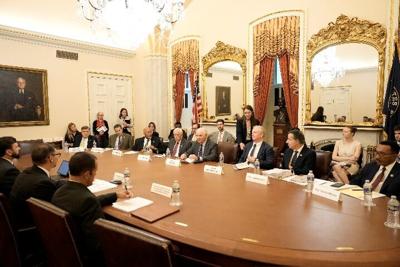CHESAPEAKE BAY, MD - Maryland’s U.S. Senators and Representatives gathered in Washington D.C. Wednesday to address the looming expiration of the Chesapeake Bay Watershed Agreement, with the Bay’s clean-up efforts falling short of the agreement’s goals.
The Chesapeake Bay Watershed Agreement is a multi-state effort to clean the Bay, with a 2025 target date for completion of a variety of restoration goals.
The EPA has been warning since at least 2022 that the Bay was not on track to reaching those 2025 pollution reduction goals. In 2023, the EPA agreed to increase its oversight of Pennsylvania’s sizable role in Chesapeake Bay pollution after Maryland, Virginia, Delaware and the District of Columbia filed a lawsuit alleging the state wasn’t holding up its end of the Watershed Agreement.
On September 25th, Maryland’s U.S. Senators Ben Cardin and Chris Van Hollen, along with Congressmen Steny Hoyer, Dutch Ruppersberger, John Sarbanes, Kweisi Mfume, Jamie Raskin, and Glenn Ivey met with representatives of the Environmental Protection Agency (EPA), the U.S. Department of the Interior, and the Maryland Department of Natural Resources (DNR) to discuss next steps for restoring the Chesapeake Bay.
Though the Bay last earned a C+ on a report card issued by the University of Maryland Center for Environmental Science and won’t meet the 2025 goals, Maryland officials remain optimistic about the Bay’s future.
“Team Maryland will always fight for the Bay. The Chesapeake Bay is a national treasure, and its restoration is a model for regional, multi-jurisdictional landscape stewardship. It is a model for other regions and other environmental protection efforts at many scales – and it is not simple,” said Senator Cardin. “As the Chesapeake Bay program is recalibrated for the next phase of action, we are committed to securing additional federal resources. We have high expectations for future results.”
In July of this year, the EPA’s Chesapeake Bay Program formed “Beyond 2025,” aimed at extending the cleanup efforts of the bay past the expiration of the Chesapeake Bay Watershed Agreement between the Bay area states. Among the members of that project is the State of Maryland.
“We look forward to sustained collaboration with federal, state and local government partners as we continue to support Beyond 2025 planning,” said Congressman Sarbanes.
Longtime waterman Floyd Walters says he's witnessed the benefits of the 2014 Chesapeake Bay Watershed Agreement, but says there's still more to be done.
"I've seen some good improvements in the Bay, but I've also seen issues that cause dead zones in the middle of the Chesapeake Bay that causes serious problems as far as the wildlife that exists in the bay on shore or in the water itself," says Walters.
Salisbury University Environmental Studies Professor Tom Horton agrees. He says recent science outlines why we are not meeting those goals and what it will take to meet them.
"We have to focus on the landscape, on urban stormwater, on agricultural pollution," Horton. "We really have to focus on Pennsylvania."
On Thursday, just a day after their meeting, Maryland lawmakers announced more than $10 million of federal funds set aside for the restoration and preservation of the Chesapeake Bay watershed.
More information on Beyond 2025 and its steering committee can be found here.



